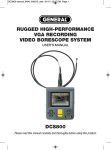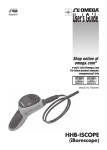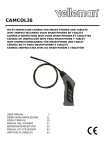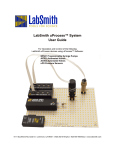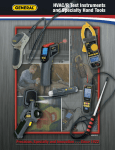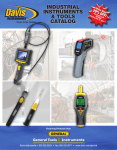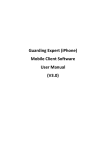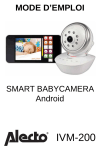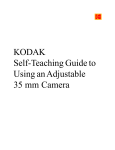Download iBORESCOPE DCiS1 - General Tools And Instruments
Transcript
iBORESCOPE USER’S MANUAL DCiS1 Please read this manual carefully and thoroughly before using this product. TABLE OF CONTENTS Introduction . . . . . . . . . . . . . . . . . . . . . . . . . . . . . . . . . . . . . . . . . . 3 Key Features . . . . . . . . . . . . . . . . . . . . . . . . . . . . . . . . . . . . . . 3 – 4 Safety Instructions . . . . . . . . . . . . . . . . . . . . . . . . . . . . . . . . . . . . . 4 What’s in the Case . . . . . . . . . . . . . . . . . . . . . . . . . . . . . . . . . . . . . 4 Product Overview . . . . . . . . . . . . . . . . . . . . . . . . . . . . . . . . . . . 4 – 5 Setup Instructions . . . . . . . . . . . . . . . . . . . . . . . . . . . . . . . . . . 6 – 7 Charge the Battery . . . . . . . . . . . . . . . . . . . . . . . . . . . . . . . . 6 Download the App (Apple iOS and Android Devices) . . . . . . . 7 Operating Instructions—Apple iOS Platform . . . . . . . . . . . . . 8 – 11 Viewing Live Video . . . . . . . . . . . . . . . . . . . . . . . . . . . . . . . . . 8 Taking and Viewing Photos. . . . . . . . . . . . . . . . . . . . . . . . . . . 9 Recording and Playing Back Videos . . . . . . . . . . . . . . . . 9 – 10 Advanced Settings . . . . . . . . . . . . . . . . . . . . . . . . . . . . . . . . 11 Operating Instructions—Android Platform . . . . . . . . . . . . . . 11 – 16 Viewing Live Video . . . . . . . . . . . . . . . . . . . . . . . . . . . . 11 – 12 Taking and Viewing Photos. . . . . . . . . . . . . . . . . . . . . . . . . . 12 Recording and Playing Back Videos . . . . . . . . . . . . . . . . . . . 13 Advanced Settings . . . . . . . . . . . . . . . . . . . . . . . . . . . . 14 – 16 Using the Probe. . . . . . . . . . . . . . . . . . . . . . . . . . . . . . . . . . . . . . . 17 Installing Accessories . . . . . . . . . . . . . . . . . . . . . . . . . . . . . . 17 – 18 Specifications . . . . . . . . . . . . . . . . . . . . . . . . . . . . . . . . . . . . . . . 18 Operating & Maintenance Tips . . . . . . . . . . . . . . . . . . . . . . . . . . . 19 Warranty Information . . . . . . . . . . . . . . . . . . . . . . . . . . . . . . 19 – 20 Return for Repair Policy . . . . . . . . . . . . . . . . . . . . . . . . . . . . . . . . 20 2 INTRODUCTION Thank you for purchasing General Tools & Instruments’ (General’s) DCiS1 iBorescope. Please read this manual carefully and thoroughly before using the instrument. iBorescope is a unique instrument that can wirelessly stream high-quality video from a camera at the tip of a long probe to the screen of a nearby iPhone® or iPad® or Android™ smartphone or tablet computer. Typical applications include inspections of hard-to-reach or hard-to-see areas like crowded engine compartments, equipment enclosures or HVAC ductwork. To receive the video, an iPhone or iPad must install and run a free app (called iBORESCOPE), downloadable from the iTunes® App Store. Similarly, an Android device must install and run the Android version of the same free app after downloading it from the Google Play Store. Soft buttons on each app allow the user to record inspection video clips and take snapshots of the video stream and store them on the iPhone, iPad or Android device. A saved clip or snapshot can be shared immediately by attaching it to a text message, or shared later via e-mail or Skype™. All transfers between iBorescope and the iPhone/iPad or Android device are wireless, via an ad hoc WiFi hot spot (without Internet access) generated by the instrument. KEY FEATURES • Generates ad hoc WiFi network (without Internet access) for transmitting transmit probe video to app-enabled iPhone/iPad or Android-based smartphone or tablet • Long 6 ft. (1.83m), thin (0.39 in./9.8mm diameter) flexible-obedient probe captures VGA (640 x 480 pixel) resolution video. A longer (9.8 ft./3m) probe with the same diameter is also available. • Excellent camera depth of field of 1/2 in. to 12 in. (12.7 to 305mm) and field of view of 54° • App’s RECORD and SNAP SHOT soft buttons capture .mp4 (Apple) or .m4v (Android) video clips and still .jpg images of live video stream and save files to the Photos folder of an Phone/iPad or the SD card folder of an Android device. Video clips and still photos can be viewed immediately, shared immediately by text, or shared later by e-mail or Skype. iPad®, iPhone® and iTunes® are trademarks of Apple Inc., registered in the U.S. and other countries Android™ is a trademark of Google Inc. Skype™ is a trademark of Skype Limited 3 • Non-replaceable Li-ion battery charges through included USB cable (compatible with iPhone/iPad/Android Power Adapter and all computers). Full charge is good for three hours of operation. • Thumbwheel on pistol grip controls camera lighting • Apple app allows adjustment of video attributes (brightness, contrast, hue, saturation); Android app allows adjustment of video resolution • Video Out jack and cable and Low Battery indicator • Includes three useful probe tip accessories (45° mirror, pickup hook, magnetic pickup) SAFETY INSTRUCTIONS • WARNING! • Do not use iBorescope to inspect spaces or enclosures known or suspected to contain live electrical wiring. WHAT’S IN THE CASE The iBorescope’s grip and probe come pre-attached in a protective hard plastic case along with a USB charging cable (compatible with the iPhone/iPad/Android Power Adapter and all computers), a video cable, three probe tip accessories (a 45° mirror, a magnetic pickup and a pickup hook) and this user’s manual. PRODUCT OVERVIEW Fig. 1 shows the controls, indicators and physical features of the iBorescope instrument. Fig. 2 shows the unit’s standard accessories. Familiarize yourself with the names and functions of all components before moving on to the Setup Instructions and Operating Instructions. 1 10 9 6 8 3 7 5 4 4 2 Fig. 1. The controls, indicators and physical features of iBorescope 1. WiFi status light: Red = Preparing hot spot; Green = Hot spot available 2. Video Out jack 3. DC5V charging jack 4. (Charging) light: Orange = Charging; Off = Fully charged 5. LOW battery charge light (glows red) 6. Power switch/brightness adjustment thumbwheel 7. Pistol grip 8. Camera-tipped probe 9. Camera head 10. RESET button (under left side of WiFi dome; press with end of paper clip and hold for 10 seconds to reset the iBORESCOPE app’s WiFi Service Set Identifier (SSID) and password to the factory defaults of “iBorescope” and “12345678”, respectively. 11 12 13 14 15 Fig. 2. iBorescope’s standard accessories 11. 45° mirror 12. Pickup hook 13. Magnetic pickup 14. Video cable 15. USB charging cable 5 SETUP INSTRUCTIONS CHARGE THE BATTERY To charge iBorescope’s battery, insert the USB plug end of the provided charging cable into the charging port on your iPad Power Adapter or iPhone/Android Power Adapter (see figures below). Insert the other end of the cable into the DC5V jack (Fig. 1, Callout 3) on iBorescope. USB charging cable iPad Power Adapter (not included) USB charging cable iPhone/Android Power Adapter (not included) Alternatively, you can charge iBorescope (very slowly, via a trickle charge) by inserting the USB plug end of the cable into a USB port of any computer. While iBorescope is charging, the light on the right side of the grip (Fig. 1, Callout 4) will glow orange. To determine whether the unit is fully charged, you must disconnect the charging cable. If the unit is fully charged, the orange light will extinguish. If not, the light will remain orange. If the battery is very low on charge, the LOW LED at the left of the orange light will illuminate. Once your iBorescope’s battery has fully charged, you can disconnect the USB charging cable from the unit and begin using it as a battery-powered instrument. A fully charged battery will power the instrument for about 3 hours. It takes about 7 hours to fully charge a depleted iBorescope battery. While you wait, you can 1) download the app for the instrument (see next section) and 2) begin learning how the unit works while connected to a source of charging current. 6 DOWNLOAD THE APP (APPLE iOS AND ANDROID DEVICES) To download the free Apple app that enables iBorescope (the instrument), first make sure that your iPhone or iPad is connected to the Internet. Then touch the App Store icon to visit the Apple App Store. Then enter “iBorescope” in the Search box. When iBorescope’s landing page appears, touch the Free App link at the upper left of the page. You will be prompted to sign in to the iTunes Store using your Apple ID and password. If you do not have an Apple ID, you can create one now. Before downloading the app, you will be shown Apple’s Privacy Policy page. Select the box indicating that “I have read and agree to these terms and conditions.” Then touch Agree. Doing so will return you to the landing page of the iBorescope app and begin downloading it. To download the free Android app that enables iBorescope (the instrument): 1. Make sure that your device is connected to the Internet. 2. Go to the Google Play Store and enter “iBorescope” in the Search box at the top of the store’s home page. 3. On the APPS screen that appears next, touch the iBORESCOPE Teamforce icon. 4. On the iBORESCOPE app’s landing page that appears next, touch the Install button at upper right. 5. On the next screen, touch the “Accept & download” button. 6. While the app downloads, on the following screen check the “Allow automatic updating”box The installation should take less than a minute. Installation is complete when you receive a notification that “iBORESCOPE [has been] “Successfully installed.” To activate the iBORESCOPE app and begin displaying inspection video on your Apple iOS or Android device, you must disconnect from the Internet and establish connectivity between your device and iBorescope's ad hoc WiFi network by following the Operating Instructions for your platform in the next section. 7 OPERATING INSTRUCTIONS— APPLE iOS PLATFORM VIEWING LIVE VIDEO 1. Turn on iBorescope by rolling the power switch/brightness adjustment thumbwheel (Fig. 1, Callout 6) to the right until you hear a click. The WiFi status light on top of the unit will glow red for 30 seconds while iBorescope prepares to generate an ad hoc hot spot (without Internet connectivity). 2. When the red light turns green, power on your device and touch the Settings icon to open your Settings screen. Your next step will be to enable your device for wireless access to available WiFi networks. 3. Touch the WiFi row to enter the WiFi Networks screen. The iBORESCOPE hot spot should appear in the list of available networks. Touching the iBorescope row connects the instrument to the network, enabling wireless transmission of probe video to a nearby iPhone or iPad running the iBORESCOPE app. When a connection has been established, a check mark will appear in the iBorescope row. Be aware that while you are connected to the ad hoc iBorescope WiFi network, your iPhone/iPad will not have Internet connectivity. The first time you try to connect to the hot spot, you may be prompted to enter the app’s password (the default password is 12345678). Thereafter, you will not be asked for a password; the iBorescope row will already have a check mark. 4. Touch the button on your iPhone/iPad to back out of the WiFi Networks and Settings screens. 5. Locate the iBORESCOPE icon among your apps and touch it. The app’s green splash screen (shown at right) will appear. 6. There are four soft buttons at the bottom of the iBORESCOPE app for iOS devices. Initially, the left (IMAGE) button is the only one that is active. Touch it to view live video captured by iBorescope’s camera-tipped probe. 7. Enabling live video activates the other three buttons at the bottom of the app. Touching the VIDEO button toggles the display between live video and a freeze frame of the video. The freeze frame remains on-screen until you touch the VIDEO button again, but it is not saved in memory. Touching the VIDEO button also toggles its icon between and . 8 TAKING AND VIEWING PHOTOS 1. To save a still image (also called a screen grab) of live video or paused video, touch the SNAP SHOT soft button at the bottom of the app. The familiar sound of a camera shutter confirms that a picture was taken. Pictures are stored as .jpg files in the Camera Roll subfolder of the Photos folder of your iPhone/iPad. 2. To view your photos, touch the button on your device to back out of the iBORESCOPE app. Locate your Photos icon and select it. By default, all of the photos you take with iBorescope are stored in the Camera Roll subfolder with a thumbnail view. Touch any thumbnail to expand the image to fill the screen of your iPhone/iPad using your preferred photo viewing app. 3. While your iPhone/iPad is connected to iBorescope’s ad hoc WiFi network, your mobile device will not have Internet access. So if you want to share any snapshots immediately, you must do so by attaching them to text messages you send over your cellular network. After you have disconnected your device from the iBorescope network, you can connect to another WiFi network with Internet access and share your pictures using e-mail or Skype. RECORDING AND PLAYING BACK VIDEOS To record a clip of live probe video appearing on your iPhone/iPad screen, touch the soft (Record) button at the lower right of the app window. Pressing the button 1) causes the button to change color and begin flashing, 2) starts a running clock indicating the clip’s duration so far on the left side of the window, and 3) begins to temporarily store an .avi video clip in the app. (To permanently store the clip in the Camera Roll subfolder of your iPad/iPhone’s Photos folder, see the instructions below for exporting video clips.) To stop recording the video clip, touch the button again. To prepare to play back a video clip, touch the soft (PLAY BACK) button at the bottom right of the app window. This open your device’s file manager and displays a screen similar to the one at right. File manager lists all recorded video clips by name, size and date. 9 To play back a video clip, touch its line. To delete a video clip: 1.Touch the Delete button in File Manager 2. Apply a minus sign to the clip to be deleted 3. Touch the Trash button that appears 4. Touch the Delete button again to return to normal view in File Manager Another way to delete a video is to quickly swipe your finger over its listing with a motion from the right edge of the screen toward the center. This will cause the Trash button to appear. Touch it to delete the video clip. To delete all stored video clips, press the Clear button in File Manager. As mentioned earlier, video clips recorded using iOS devices are temporarily saved as .avi files within the iBORESCOPE app. If you wish to view any clip after closing the app, share the clip with someone, or view the clip on another device later, you must “export” it. The process of exporting a clip permanently saves it to the Camera Roll subfolder of your iPad/iPhone’s Photos folder and changes its file type from .avi to .mp4. Video icons are attached to exported video clips to distinguish them from stored images. To export a video clip, touch the Export button in File Manager and select the clip by touching its listing. To confirm that you wish to proceed, touch the OK button on the next screen. To attach an exported video clip to an e-mail message, you must first exit the iBORESCOPE app and disconnect from the instrument’s ad hoc WiFi spot. Only then can you connect to a conventional WiFi hot spot with Internet connectivity. Any stored .mp4 clip that you attach to an e-mail message is converted to a .MOV file that—unlike the typical .MOV file—can be opened by the PC platform’s most popular media player—Windows Media Viewer. To exit File Manager and resume showing real-time video on your iPhone/iPad screen, touch the Live View soft button at upper left. 10 ADVANCED SETTINGS To change the iBORESCOPE iOS app’s advanced settings, touch the Setting button at the upper right of the app. The screen at right will appear. As the screen shot shows, you can change the app’s WiFi Service Set Identifier (SSID) or password or adjust its video settings while watching live video in the Preview window in the middle of the screen. The default WiFi SSID for the unit is iBORESCOPE. The default WiFi password is 12345678. You can change either value to any combination of letters and numbers that is at least eight digits long. Enter the new value in the appropriate field and touch the adjacent Apply button. To adjust the brightness, contrast, hue or saturation of live probe video, move the appropriate slider to the left or right. To restore the factory-default values of all advanced settings, touch the Restore button. OPERATING INSTRUCTIONS— ANDROID PLATFORM VIEWING LIVE VIDEO 1. Turn on iBorescope by rolling the power switch/brightness adjustment thumbwheel (Fig. 1, Callout 6) to the right until you hear a click. The WiFi status light on top of the unit will glow red for 30 seconds while iBorescope prepares to generate an ad hoc hot spot (without Internet connectivity). 2. When the red light turns green, power on your device and touch the (Menu) button at lower left, followed by the System Settings line. 3. Touch the ON soft button on the right side of the Wi-Fi row to enable WiFi connectivity. 11 4. Touch the left side of the Wi-Fi row to enter the Wi-Fi Networks screen. iBorescope’s hot spot should appear in the list of available networks. Touch the iBORESCOPE row, and then the Connect soft button at the right of the next screen. When “Connected” appears in the iBorescope row, your Android device is ready to receive wireless transmissions of probe video. Be aware that while you are connected to the ad hoc iBorescope WiFi network, your device will not have Internet connectivity. The first time you try to connect to the hot spot, you may be prompted to enter the app’s password (the default password is 12345678). Thereafter, you will not be asked for a password; the iBORESCOPE row will already have a check mark. 5. Touch the Home or button on your device to exit the Wi-Fi networks screen. 6. Locate the iBORESCOPE icon among your apps and touch it. The screen at right will appear, with live video in the main viewing area. TAKING AND VIEWING PHOTOS To save a still image (also called a screen grab) of live video or paused video, touch the SNAP SHOT soft button at the right side of the app. The familiar sound of a camera shutter confirms that a picture was taken. All photos you take are immediately and permanently stored as .jpg files in a dedicated “iBORESCOPE” subfolder of the “sdcard” folder of your Android device. Any photos you take will be saved to this folder even if no SD card is installed in your device, or an SD card is installed and it is full. If an SD card is missing or full, when you touch the SNAP SHOT button an on-screen prompt will advise “Image Saved in Album!” To view your pictures, touch the button on your device to exit the iBORESCOPE app. Locate your iBorescope subfolder and open it. The files of all of the photos you have taken on that phone using the iBORESCOPE app are stored as tiles. Touch any tile to view the corresponding photo. Use pinch motions to expand or shrink any displayed image as desired. 12 RECORDING AND PLAYING BACK VIDEOS To record a clip of live probe video appearing on the screen of your Android device, touch the soft (RECORD) button on the right side of the app window. Pressing the button 1) causes a red button to appear in the lower left corner of the screen, 2) superimposes the message, Video Recording starts. on the display, 3) starts a running clock indicating the clip’s duration so far in the upper left corner of the window, and 3) begins storing an .m4v video clip in the RecordVideo subfolder of the sdcard folder of your Android device (even if no SD card is installed in your device, or an SD card is installed and it is full.) To stop recording the video clip, touch the (STOP) button on the right side of the app window. To prepare to play back a video clip, touch the soft (PLAY BACK) button at the bottom right of the app window. This will cause the screen at right to appear: To play back a video clip, touch its row. This will 1) cause the video to begin playing, 2) superimpose the message Video Playback starts. on the display, 3) start a running clock indicating the playback position in the upper left corner of the app window, and 4) replace the (PLAY BACK) icon by the (STOP) icon. To stop playback of a video clip before it completes, touch the (STOP) button. To delete a video clip, touch the red “X” at the right side of its row. To attach a stored video clip to an e-mail message, you must first exit the iBORESCOPE app and disconnect from the instrument’s ad hoc WiFi spot. Only then will you be able to connect to a conventional WiFi hot spot with Internet connectivity. Any stored .m4v clip that you attach to an e-mail message is converted to an .mp4 file that may or may not be able to be opened by the PC platform’s most popular media player—Windows Media Viewer—depending on the player’s supporting cast of codecs. Most video files, including .mp4 files, can be opened by versatile media players such as freeVLC (www.videolan.org). 13 ADVANCED SETTINGS To change the iBORESCOPE Android app’s advanced settings, touch the (SETTING) button at the upper right of the app. The following screen will appear. Touching the Wi-Fi Setting row produces the following screen. Using this screen, you can change either the default WiFi Service Set Identifier (SSID) of iBORESCOPE or password of 12345678 to any string of at least eight letters from A to Z and numbers from 0 to 9. If you make a change, remember to touch the OK button to save the setting. 14 Touching the Video Setting row of the initial Setting screen produces the screen at right. Note that although the app’s default video recording resolution is QVGA (320 x 240 pixels), the pulldown on the Current Profile line gives you the option to increase the resolution to QVGA (640 x 480 pixels). Select MPEG4 VGA to match the resolution of the camera at the tip of the probe of iBorescope (the instrument). The only reason to record video clips at the lower, QVGA resolution is to produce smaller clips that require less memory space to store and less bandwidth to share via e-mail. If you make a change, remember to touch the OK button to save the setting. Touching the Set Framerate row of the initial Setting screen produces the screen at right. Note that although the app’s default video frame rate is 15 fps (frames per second), the pulldown on the Current Framerate line gives you the option to increase the frame rate to 25 fps. 15 Select 25 fps to maximize the quality of your video clips. The only reason to record video clips at the lower, 15 fps frame rate is to produce smaller clips that require less memory space to store and less bandwidth to share via e-mail. If you make a change, remember to touch the OK button to save the setting. Touching the Reset to Default row of the initial Setting screen produces the screen at right. Touch Yes to restore all factory default settings (for SSID and password, video recording resolution and video frame rate). Touching the About row of the initial Setting screen produces the following screen with the app’s release date. 16 USING THE PROBE If you are unfamiliar with video borescopes, be aware that professional users like contractors and technicians typically insert a borescope probe into an orifice (a hole in a wall or an engine’s cylinder, for example) or into an inaccessible or hazardous area (the back or an equipment rack or an engine compartment, for example) to view components or environments that would otherwise be invisible. Use the brightness adjustment thumbwheel (Fig. 1, Callout 6) to match the intensity of camera lighting to the application environment. In practice, professionals usually insert flexible-obedient probes like the one that comes with iBorescope head-on into an orifice or area as a first step. They then pull the probe out and adjust its bend one or more times until the camera in the tip is pointing directly at the target or area of interest. With the probe inserted, you can twirl it until video appears right-side up, but in many cases you cannot change the probe’s angle of approach very much. INSTALLING ACCESSORIES iBorescope comes with three accessories (see left photo below) in a Ziploc bag that attach to the camera-tipped end of the probe. Each accessory has a specific purpose: • The 45° mirror lets the probe see around corners. • The pickup hook lets you retrieve otherwise inaccessible items seen by the probe—for example, a wedding ring accidentally dropped down a sink drain. • The magnetic hook lets you retrieve lost or dropped metal objects—nuts and bolts, for example—located by the probe. To attach an accessory: 1. Hold its metal stem with your thumb and index finger. 2. Slide the accessory—plastic clasp first—past the camera head at the probe tip until the clasp is in the channel 1/4 in. from the end of the probe. 17 3. Squeeze the clasp until you hear a click (see right photos on previous page), indicating that the two halves have joined. To detach an accessory: 1. Use the nail of your index finger to unhook the clasp, opening it up. 2. Hold the accessory’s metal stem with your thumb and index finger and slide the accessory and clasp past the camera head. 3. Put the accessory back in the Ziploc bag it came in. SPECIFICATIONS Compatible with Security Video Resolution Frame Rate Streaming Video Format WiFi Range Camera Lighting Camera Head Diameter Camera Depth of Field Camera Field of View Probe Length Probe Minimum Bending Radius Dust & Water Resistance Rating (Probe & Camera Head only) Operating Voltage Current Consumption Operating Temperature Power Supply Life of Full Battery Charge 18 iPad, iPad2, “iPad3”, iPhone3GS, Phone 4S, iPhone5, iPod touch (3rd, 4th, 5th generation) running iOS4.1 or later; any device running Android 2.2 or higher WiFi (WEP) password 640 x 480 pixels (VGA) 30 frames per second (fps) MPEG4 60 ft. (18m), max (unobstructed) 2 white LEDs 0.39 in. (9.8mm) 1/2 in. to 12 in. (12.7 to 305mm) 54° 6 ft. (1.83m) 1.77 in. (45mm) IP67 3.7V internal from 5V input 850 mA, max @ 5VDC 32° to 104°F (0° to 40°C) Rechargeable 2300 mAh Li-ion battery with 5V/1A output 3 hours, typical OPERATING & MAINTENANCE TIPS Never insert the probe into a fuel tank or a flammable liquid or gas such as unleaded gasoline, diesel fuel, machine oil, DOT 4 brake fluid or transmission fluid. The probe contains thin wires running along its entire length. Accordingly, handle it with care: • Do not bend it more than 90° anywhere along its length. • Do not bend the probe more than 70° within 1.2 in. (30mm) of its camera tip. • Do not bundle the probe into a tight circle to store it. • Never use the camera end to clear its own path of debris. • Do not overtighten the collar that secures the probe to the handle. To clean the camera lens and LEDs, use a cotton swab and a small amount of mild detergent. The grip requires no routine maintenance other than periodic cleaning with a soft, dry cloth. Never use a wet cloth, corrosive liquids, solvents or water. Avoid getting the grip wet. Operate and store iBorescope only in a cool (under 140°F or 60°C), dry, wellventilated place. Avoid exposing the unit to sunlight for long periods of time. iBorescope is designed for industrial and environmental use only. Never use it for human or any other biological inspection. WARRANTY INFORMATION General Tools & Instruments’ (General’s) DCiS1 iBorescope is warranted to the original purchaser to be free from defects in material and workmanship for a period of one year. Subject to certain restrictions, General will repair or replace this instrument if, after examination, the company determines it to be defective in material or workmanship. This warranty does not apply to damages that General determines to be from an attempted repair by non-authorized personnel or misuse, alterations, normal wear and tear, or accidental damage. The defective unit must be returned to General Tools & Instruments or to a General-authorized service center, freight prepaid and insured. 19 Acceptance of the exclusive repair and replacement remedies described herein is a condition of the contract for purchase of this product. In no event shall General be liable for any incidental, special, consequential or punitive damages, or for any cost, attorneys’ fees, expenses, or losses alleged to be a consequence of damage due to failure of, or defect in any product including, but not limited to, any claims for loss of profits. RETURN FOR REPAIR POLICY Every effort has been made to provide you with a reliable product of superior quality. However, in the event your instrument requires repair, please contact our Customer Service to obtain an RGA (Return Goods Authorization) number before forwarding the unit via prepaid freight to the attention of our Service Center at this address: General Tools & Instruments • 80 White Street • New York, NY 10013 • 212-431-6100 • Remember to include a copy of your proof of purchase, your return address, and your phone number and/or e-mail address. GENERAL TOOLS & INSTRUMENTS 80 White Street New York, NY 10013-3567 PHONE (212) 431-6100 FAX (212) 431-6499 TOLL FREE (800) 697-8665 e-mail: [email protected] www.generaltools.com DCiS1 User’s Manual Specifications subject to change without notice ©2013 GENERAL TOOLS & INSTRUMENTS NOTICE - WE ARE NOT RESPONSIBLE FOR TYPOGRAPHICAL ERRORS. MAN #DCiS1 031413 20





















